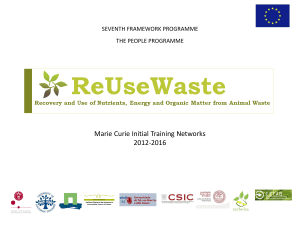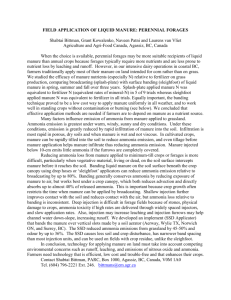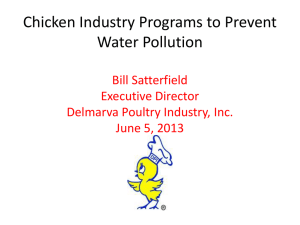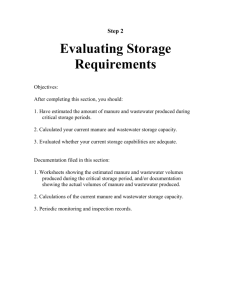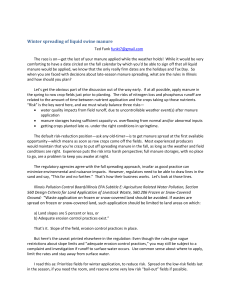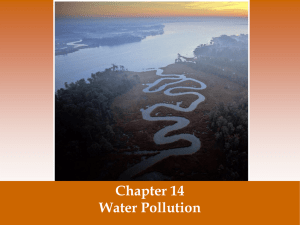Step 8 (Word document)
advertisement
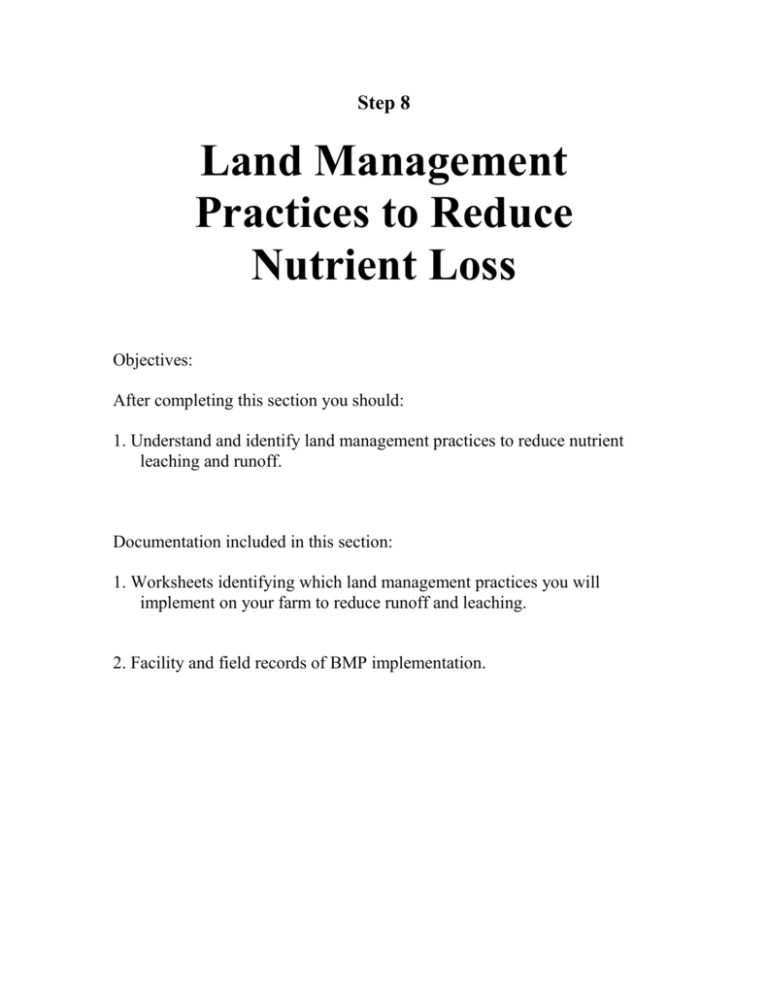
Step 8 Land Management Practices to Reduce Nutrient Loss Objectives: After completing this section you should: 1. Understand and identify land management practices to reduce nutrient leaching and runoff. Documentation included in this section: 1. Worksheets identifying which land management practices you will implement on your farm to reduce runoff and leaching. 2. Facility and field records of BMP implementation. Best Management Practices Minimizing surface runoff and leaching reduces the likelihood that contaminated water from fields will enter a surface or ground water source. Many conservation and land management practices have been proven to reduce leaching and runoff. These practices are referred to as Best Management Practices (BMPs). Voluntary adoption of these practices is encouraged by all livestock producers. It is not expected that all operations should adopt all of the practices listed. Rather, operators should evaluate these practices and adopt as many as they can that fit within their management system. BMPs should be adopted on sites where the risk of contaminating surface or ground water is high. Review the conservation/best management practices described below. Indicate which practices are or will be implemented using the checklist and/or worksheet at the end of this section. General BMPs • Identify fields at high risk for leaching and/or runoff and don’t apply manure or apply at lower rates, and don’t apply manure to these fields during winter. • Consider grazing as an alternative to confinement to reduce the need for manure storage, handling, and spreading. • Regularly sample manure and soils and calculate manure application rates based on realistic crop yields and procedures described in this publication. • Reduce commercial fertilizer rates accordingly when manure is used as a nutrient source. • Document all land management practices used to prevent surface runoff and leaching. Both photos and written documentation demonstrate awareness and implementation of BMPs. Specific BMPs to reduce leaching • Irrigation water management. Maintain irrigation systems and practice good water management during the growing season, especially on coarse textured soils. • Don’t apply manure, or apply manure at reduced rates (e.g., based on phosphorus), on fields with shallow water tables, coarse-textured soils, or other soil limitations. Specific BMPs to reduce runoff • Berm fields adjacent to surface water sources to contain runoff. • Use application setbacks and/or vegetated filter strips where manure is applied to fields adjacent to a surface water source. • Don’t apply manure, or apply manure at reduced rates (e.g., based on phosphorus), to steeply sloped fields and/or fields near surface water sources. • Apply manure to fields with as much vegetative or crop residue cover as possible, or incorporate manure immediately following application. Additional notes Checklist of Best Management Practices Lot and storage areas Instructions: Place a “” in each box indicating which conservation practices have been implemented or if the practice is not needed. It the practice will be implemented indicate the date of implementation. Practice Implemented Date to be Implement Not needed Lot and storage areas Berm, ditch, gutter or otherwise divert all clean storm water away from the lot and manure stockpiles or bunkers Pipe or otherwise enclose ditches or small streams that run through or near the lot Locate manure stockpiles and lagoons above the flood plain and away from surface water sources and well heads Contain all runoff from manure stockpiles and lot areas When scraping soil-based lots do not disrupt the compacted surface layer that acts as a barrier to leaching Design manure bunkers and wastewater lagoons based on realistic storage periods for your location, field access, and manure, wastewater and runoff volumes generated Inspect lagoons and liquid manure storage ponds regularly to ensure seepage does not exceed state and local restrictions Checklist of Best Management Practices Nutrient management Instructions: Place a “” in each box indicating which conservation practices have been implemented or if the practice is not needed. It the practice will be implemented indicate the date of implementation. Practice Implemented Date to be Implement Not needed Nutrient management Develop a nutrient management plan including estimates of on-farm manure production, crop yield and nutrient uptake, soil/water/manure analysis, and calculated manure application rates Base manure application rates on phosphorus if soil test phosphorus is above 50 ppm, the field drains to a sensitive water body, or phosphorus movement is likely Apply supplemental commercial nitrogen and phosphorus to manured fields only when it has been determined that nutrients from manure will not satisfy crop needs Maintain nutrient management plans and actual manure and fertilizer management records on file for a minimum of three years or the duration of a crop rotation Scout fields for signs of nutrient deficiency or excess throughout the season in order to identify and correct problems that might limit crop yields Checklist of Best Management Practices Manure application Instructions: Place a “” in each box indicating which conservation practices have been implemented or if the practice is not needed. It the practice will be implemented indicate the date of implementation. Practice Implemented Date to be Implement Not needed Manure application Incorporate manure as soon as possible after application to minimize volatilization losses, reduce odor, and prevent runoff Apply manure uniformly with properly calibrated and operated equipment Time liquid manure applications to match crop nutrient uptake patterns to reduce the potential for nitrate leaching Limit solid manure applications on frozen or saturated ground to fields that are at low risk for runoff Create a buffer area away from surface water, irrigation return flow ditches, and well sources where no manure is applied to prevent the possibility of water contamination Apply manure on a rotational basis to fields that will be planted to high nitrogen use crops such as forages Best management practices Land management Instructions: Enter a number or identification code for each field. Place a “” in each box indicating which conservation practices have been implemented on each field. Field number or identification Practice Crop rotation Vegetative buffers Cover type/residue mgt. Application setbacks Sediment control basins Erosion control Grassed waterways Diversion Tailwater recovery Runoff containment Irrigation water mgt. Improved irrigation system Manure incorporation Manure application rate Record keeping Soil testing


